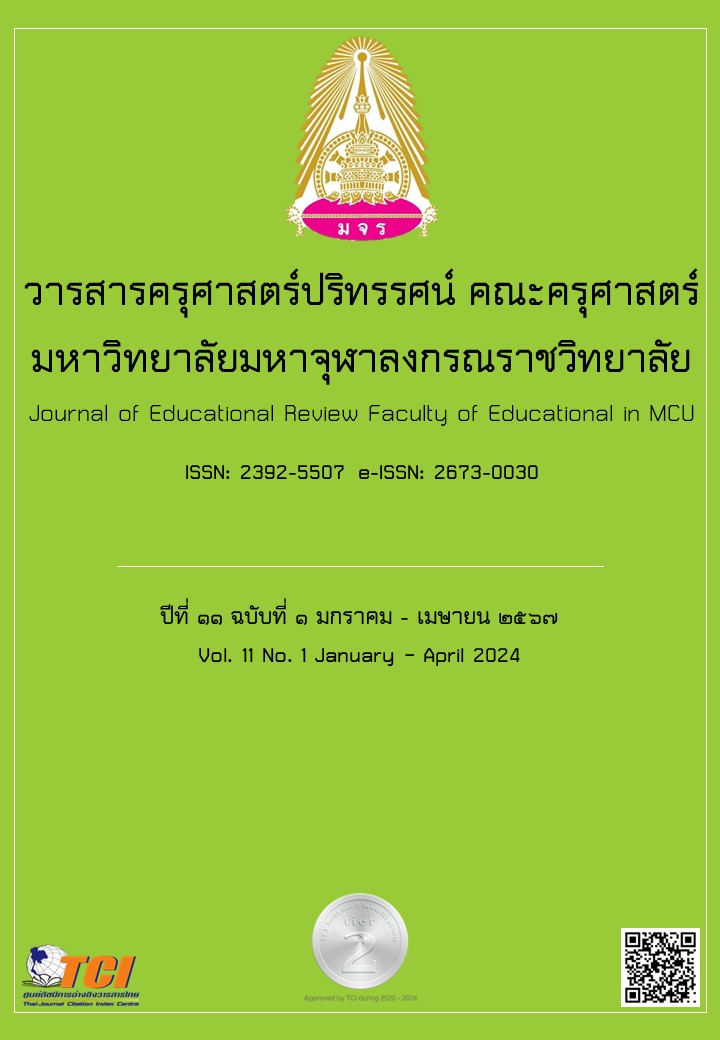NETWORK BUILDING, INNOVATION AREA FOR LEARNING THE BUDDHIST WAY OF LIFE
Main Article Content
Abstract
The objectives of this research article were to 1) Analyze the network building of the Buddhist learning innovation areas. 2) Develop a model for network building of the Buddhist learning innovation areas. 3) Study and evaluate the results of network building of the Buddhist learning innovation areas. It was qualitative research by studying documents, and group discussion interviews with administrators, teachers, parents, students, temples and communities, and students who were in a network of Buddhist learning innovation areas, 351 people, using small group discussions to confirm the data. There were 13 key informant administrators, faculty, staff, and students in the Faculty of Education and those involved in network building of the Buddhist learning innovation areas. The researcher analyzed the data by focusing on the analysis obtained from summarizing the content, analyzing and synthesizing the data and then writing a descriptive narrative. The results of the research found that: 1) network building of the Buddhist learning innovation areas, including creating inspiration for innovation in the Buddhist way, innovation training, strengthening innovation potential, and promoting investment in innovation. 2) The model for network building of the Buddhist learning innovation areas had 4 dimensions: (1) organizing basic life activities, (2) the working network dimension, (3) the target group dimension creating a collaborative working network, and (4) creating a network of Buddhist innovations. This research emphasized on integration according to the three principles of morality, concentration, and wisdom as a base. Learning through activities to develop students in 4 areas, including social networks, mental network, intellectual network, and the physical network. 3) Evaluate the results of creating a network of Buddhist learning innovation areas. There were 3 phases: the phase before network creation, the implementation phase, and the period after operation.
Article Details

This work is licensed under a Creative Commons Attribution-NonCommercial-NoDerivatives 4.0 International License.
ทัศนะและความคิดเห็นที่ปรากฏในบทความในวารสารฉบับนี้ถือเป็นความรับผิดชอบของผู้เขียนบทความนั้นเพียงผู้เดียว และไม่ถือเป็นทัศนะและความรับผิดชอบของกองบรรณาธิการ
กองบรรณาธิการขอสงวนสิทธิ์ในการคัดเลือกบทความลงตีพิมพ์และจะแจ้งให้เจ้าของบทความทราบหลังจากผู้ประเมินบทความตรวจอ่านบทความแล้ว
ต้นฉบับที่ได้รับการตีพิมพ์ในวารสารครุศาสตร์ปริทรรศน์ คณะครุศาสตร์ มหาวิทยาลัยมหาจุฬาลงกรณราชวิทยาลัย ถือเป็นกรรมสิทธิ์ของคณะครุศาสตร์ มหาวิทยาลัยมหาจุฬาลงกรณราชวิทยาลัย ห้ามนำข้อความทั้งหมดหรือบางส่วนไปพิมพ์ซ้ำ เว้นเสียแต่ว่าจะได้รับอนุญาตจากมหาวิทยาลัยฯ เป็นลายลักษณ์อักษร
References
กระทรวงศึกษาธิการ. (2551). หลักสูตรแกนกลางการศึกษาขั้นพื้นฐานพุทธศักราช 2551. กรุงเทพมหานคร: โรงพิมพ์ชุมนุมสหกรณ์แห่งประเทศไทย.
พระราชบัญญัติพื้นที่นวัตกรรมการศึกษา พ.ศ. 2562. (2562). ราชกิจจานุเบกษา เล่ม 136 ตอนที่ 56 ก หน้า 102 (30 เม.ย. 2562).
พระวิเชียร สิริภทฺโท (ประทุมมินทร์) และคณะ. (2564). การพัฒนานวัตกรรมการบริหารโรงเรียนการกุศลของวัดในพระพุทธศาสนา. วารสารครุศาสตร์ปริทรรศน์ คณะครุศาสตร์ มหาวิทยาลัยมหาจุฬาลงกรณราชวิทยาลัย. 8(3). 216-224.
พื้นที่นวัตกรรมการศึกษา. (2562). พรบ. พื้นที่นวัตกรรมการศึกษา 2562. แหล่งที่มา https://www.edusandbox.com/sandboxlaw/ สืบค้นเมื่อ 1 ก.พ. 2564.
วันเพ็ง ระวิพันธ์ และคณะ. (2562). แนวทางการใช้นวัตกรรมและเทคโนโลยีสารสนเทศด้านการจัดการเรียนรู้ของครูตามนโยบาย ไทยแลนด์ 4.0 สำนักงานเขตพื้นที่การศึกษาประถมศึกษา พระนครศรีอยุธยา เขต 2. วารสารครุศาสตร์ปริทรรศน์ คณะครุศาสตร์ มหาวิทยาลัยมหาจุฬาลงกรณราชวิทยาลัย. 6(1). 116-128.
ศิริชัย กาญจนวาสี. (2550). ทฤษฎีการประเมิน. พิมพ์ครั้งที่ 6. กรุงเทพมหานคร: จุฬาลงกรณมหาวิทยาลัย
สมเจตน์ ผิวทองงาม. (2566). การเรียนรู้ในพระพุทธศาสนา : ทฤษฎี และการนําไปประยุกต์ใช้. วารสารสมาคมพัฒนาวิชาชีพการบริหารการศึกษาแห่งประเทศไทย. 5(4). 249-266.
สมชาย บุญสุ่น. (2561). การจัดการศึกษาตามแนวพุทธจิตวิทยาในโรงเรียนวิถีพุทธ. ดุษฎีนิพนธ์พุทธศาสตรดุษฎีบัณฑิต. มหาวิทยาลัยมหาจุฬาลงกรณราชวิทยาลัย.
สำนักงานบริหารพื้นที่นวัตกรรม สำนักงานคณะกรรมการการศึกษาขั้นพื้นฐาน. (2565). พื้นที่นวัตกรรมการศึกษาทำนอกกรอบพัฒนาสมรรถนะเด็ก. แหล่งที่มา https://www.sobkroo.com/articledetail.asp?id=1035. สืบค้นเมื่อ 25 ต.ค. 2565.
สิริกาญจน์ ธนวุฒิพรพินิต และคณะ. (2566). รูปแบบการบริหารการจัดการเรียนรู้ภาษาอังกฤษแนวใหม่ตามกรอบอ้างอิงความสามารถทางภาษาของสหภาพยุโรป (CEFR) ระดับมัธยมศึกษา เชื่อมโยงกับการประกันคุณภาพการศึกษา. วารสารครุศาสตร์ปริทรรศน์ คณะครุศาสตร์ มหาวิทยาลัยมหาจุฬาลงกรณราชวิทยาลัย. 10(3). 351-362.


